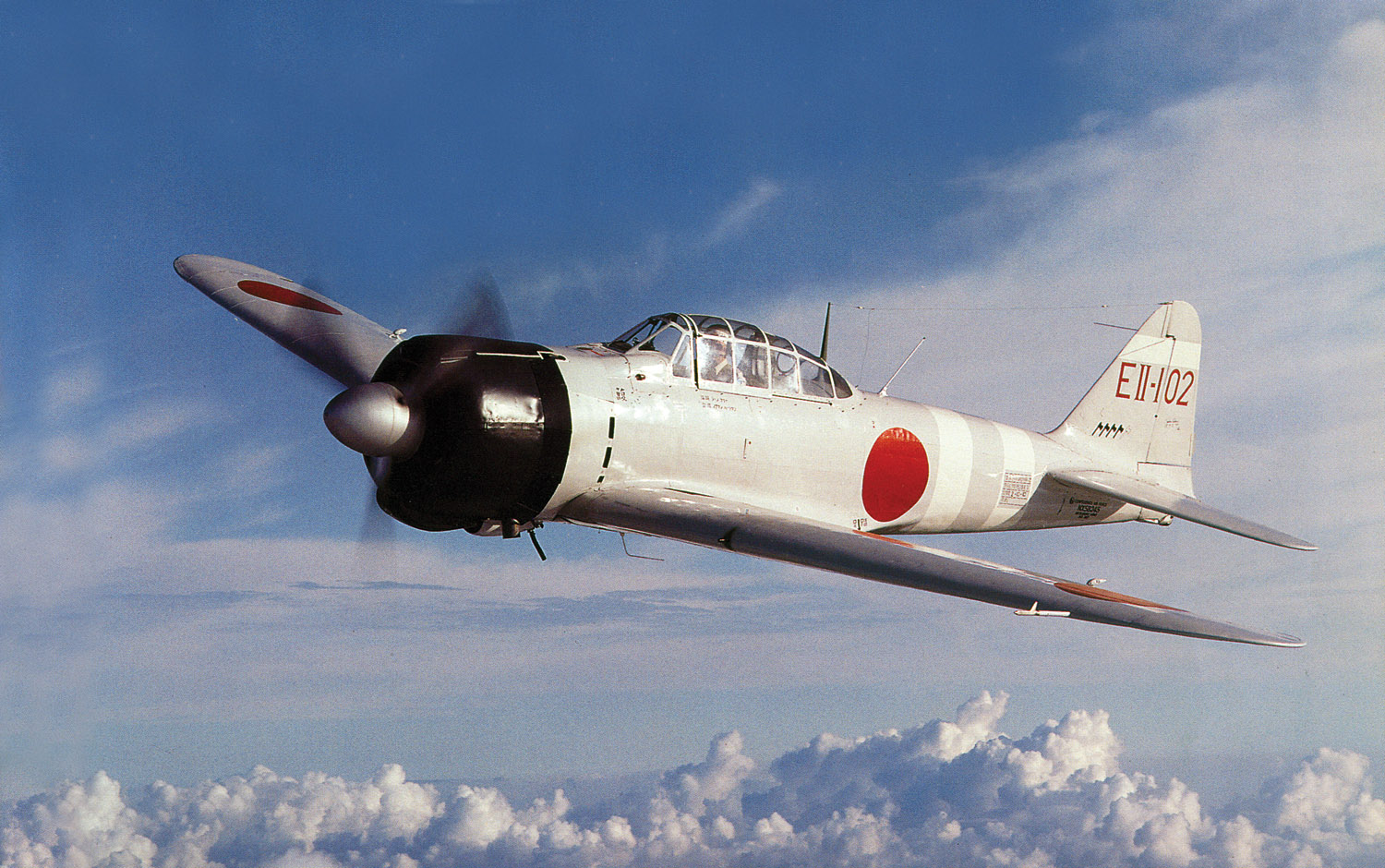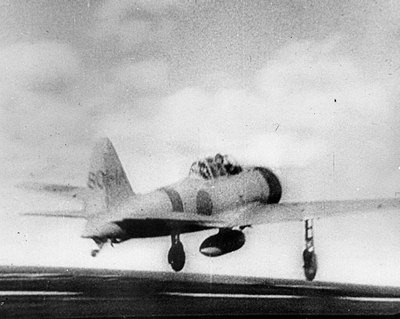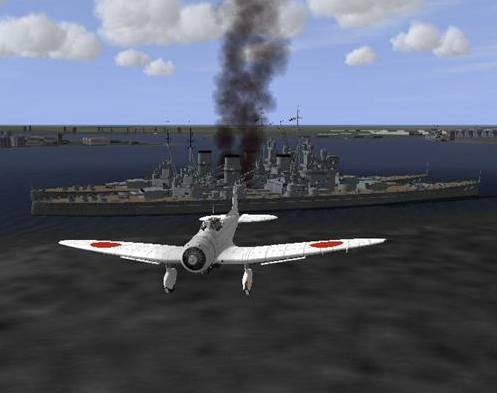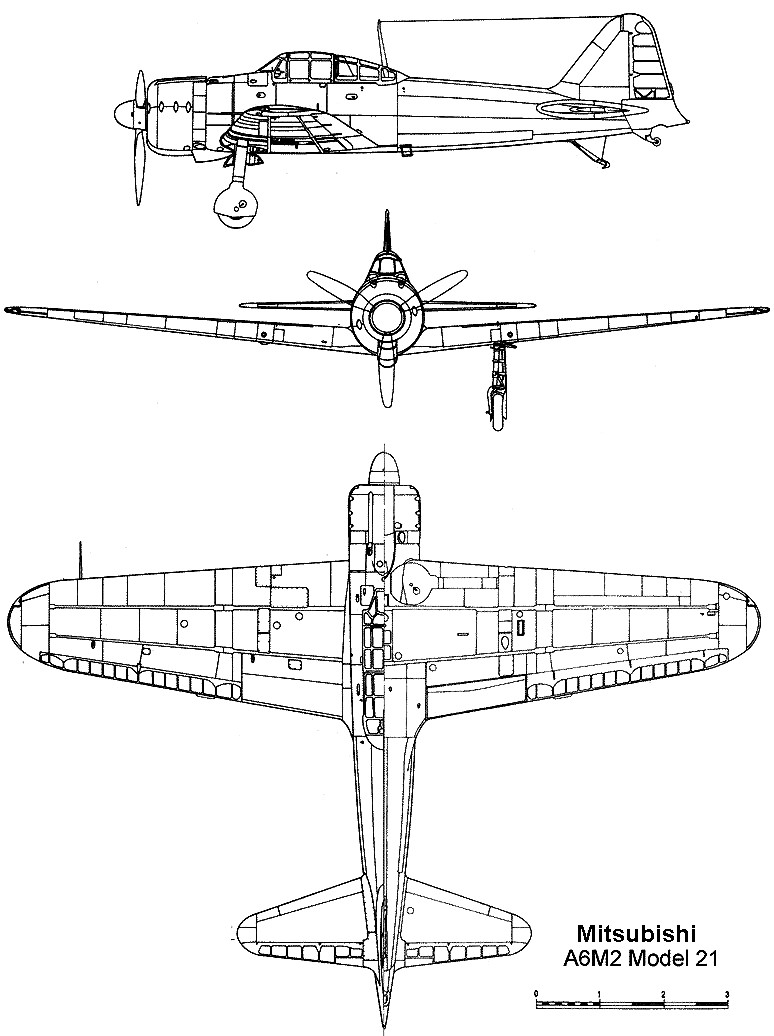Zero Reisen Mitsubishi A6M
This chapter has been inspired by the Wikipedia article on the Zero
The Mitsubishi A6M Zero was a light-weight carrier-based fighter aircraft employed by the Imperial Japanese Navy Air
Service from 1940 to 1945 and by the Chinese of both the KMT and CCP from 1945-1956.
It is universally known as Zero from its Japanese Navy designation, Type 0 Carrier Fighter, taken from the last
digit of the Imperial year 2600 (1940), when it entered service. In Japan it was unofficially referred to as
both Rei-sen and Zero-sen. The official Allied code name was Zeke (Hamp for the A6M3 model 32 variant); while
this was in keeping with standard practice of giving boys' names to fighters, it is not definitively known if
this was chosen for its similarity to "Zero".

Zero A6M2 Type 21
A combination of excellent maneuverability and very long range made it one of the best fighters of its era. In early
service the Zero gained a legendary reputation, outclassing its contemporaries. Later, design weaknesses and the
increasing scarcity of more powerful aircraft engines meant that the Zero became less effective against newer fighters.
The Mitsubishi A5M was just starting to enter service in early 1937 when the IJN started looking for its eventual
replacement. In May they issued specification 12-Shi for a new aircraft carrier-based fighter, sending it to Nakajima
and Mitsubishi. Both started preliminary design work while they awaited more definitive requirements to be handed
over in a few months.
Based on the experiences of the A5M in China, the Navy sent out updated requirements in October. The new
requirements called for a speed of 500 km/h at 4000 m, and a climb to 3000 m in 3.5 min. They needed an
endurance of 2 hours at normal power, or 6 to 8 hours at economical cruising speed (both with drop tanks).
Armament was to consist of two 20 mm cannons and two 7.7 mm machine guns, and two 30 kg or 60 kg bombs.
A complete radio set was to be mounted in all planes, along with a radio direction finder for long-range
navigation. Finally the maneuverability was to be at least equal to A5M, while the wing span had to be less
than 12 m to fit on the carriers.

A Zero taking-off for the Agaki Aircrfat Carrier
Nakajima's team thought the new requirements were ridiculous and pulled out of the competition in January.
Mitsubishi's chief designer, Jiro Horikoshi, felt that the requirements could be met, but only if the aircraft
could be made as light as possible. Every weight saving method was used, and the designers made extensive use
of the new duralumin alloy. With its low-wing cantilever monoplane layout, retractable wide-set landing gear
and enclosed cockpit, the design was not only much more modern than any the Navy had used in the past, it was
one of the most modern in the world.
There was no armor plate to protect the single pilot, no self-sealing fuel tanks, and none of the niceties found
in Allied aircraft. Most of the airplane is built of T-7178 aluminum, a top-secret variety developed by the Japanese
for the purpose. It is lighter and stronger than the normal aluminum used at the time, but more brittle.
The Zero has a fairly high-lift, low-speed wing with a very low wing-loading, giving it a very low stalling speed,
well below 60 knots. This is the reason for the phenomenal turning ability of the airplane, letting it out-turn any
Allied fighter at the time. Turning ability is very simply the ability to "pull harder," and put more g-load on
the wings before the accelerated stall occurs. Roll rate is enhanced by "servo tabs" on the ailerons which deflect
opposite to the ailerons and make the control force much lighter. The disadvantage is that they reduce the maximum
roll effect at full travel. At 160 mph (260 km/h), A6M2 had a roll rate of 56 degrees per second.
At the time of Pearl Harbor there were only 420 Zeros active in the Pacific. The carrier-borne Model 21 was the
type encountered by the Americans, often much further from its carriers than expected, with a mission range of
over 1600 statute miles (2,600 km). They were superior in many aspects of performance to all Allied fighters in
the Pacific in 1941 and quickly gained a great reputation. However, the Zero failed to achieve complete superiority
due to the development of suitable tactics and new aircraft by the Allies.

Pearl-Harbour
When the powerful Grumman F6F Hellcat, Vought F4U Corsair and Lockheed P-38 appeared on the Pacific theater,
the A6M with its low-powered engine lost its competitiveness: the US Navy's 1:1 kill ratio suddenly jumped to
better than 10:1, although in competent hands the Zero could still be deadly at the end of the war.
Because of the scarcity of high-powered aviation engines and some problems with planned successor models, the
Zero remained in production until the end, with over 11,000 of all types produced.
Designed for attack, the Zero gave precedence to maneuverability and fire-power at the expense of protection—most
had no self-sealing tanks or armour plate—thus many Zeros were lost too easily in combat along with their pilots.
Ironically, the Japanese trained their aviators far more vigorously than their Allied counterparts up to the first
part of the war.
Due to the high agility of the Zero, the Allied pilots found that the correct combat tactic against Zeros was to
remain out of range and fight on the dive and climb. By using speed and resisting the deadly error of trying to out-turn
the Zero, eventually cannon could be brought to bear and a single burst of fire was usually enough to down the Zero.
These tactics, known as boom-and-zoom, were successfully employed by the Flying Tigers (American Volunteer Group). AVG pilots
were trained to exploit the advantages of their P-40s; very sturdy, heavily armed, generally faster in a dive, and a
good rate of roll.
Another important maneuver was called the "Thach Weave", named for the man that invented it, then-Lt Cdr
John S. "Jimmy" Thach. It required two planes, a leader and his wingman, to fly about 200 feet apart. When a Zero
would latch onto the tail of one of the fighters, the two planes would turn toward each other. If the Zero followed
its original target through the turn, it would come into a position to be fired on by his target's wingman. This tactic
was used with spectacular results at the Battle of the Coral Sea and at the Battle of Midway, and helped make up for the
inferiority of the US planes until new aircraft types were brought into service.
Variants
A6M1, Type 0 Prototypes :The first A6M1 prototype was completed in March 1939, powered by the 780 hp (580 kW)
Mitsubishi Zuisei 13 engine with a two-bladed propeller. It first flew on April 1st, and passed testing in a
remarkably short period of time. By September it had already been accepted for Navy testing as the A6M1 Type
0 Carrier Fighter, with the only notable change being a switch to a three-bladed propeller to cure a vibration problem.
A6M2, Type 0 Model 11 : While the Navy was testing the first two prototypes, they suggested that the third be fitted
with the 940 hp (700 kW) Nakajima Sakae 12 engine instead. Mitsubishi had its own engine of this class in the form
of the Kinsei, so they were somewhat reluctant to use the Sakae. Nevertheless when the first A6M2 was completed in
January 1940, the Sakae's extra power pushed the performance of the plane well past the original specifications.
The new version was so promising that the Navy had 15 built and shipped to China before they had completed testing.
They arrived in Manchuria in July 1940, and first saw combat over Chungking in August. There they proved to be
completely untouchable by the Polikarpov I-16's and I-153s that had been such a problem for the A5M's currently
in service. In one encounter 13 Zeros shot down 27 I-15 and I-16's in under three minutes without loss. After
hearing of these reports the Navy immediately ordered the plane into production as the Type 0 Carrier Fighter, Model 11.
Reports of the Zero's performance filtered back to the US slowly. There they were dismissed by most planners,
who felt it was impossible for the Japanese to build such an aircraft. Others were not so sure, and techniques
were developed by Butch O'Hare to combat them just in case.
A6M2, Type 0 Model 21 :
Mitsubishi A6M2 "Zero" Model 21 on the flight deck of carrier Shokaku , 26 October 1942, Battle of the Santa Cruz Islands.
After the delivery of only 65 planes by November 1940, a further change was worked into the production lines,
which introduced folding wingtips to allow them to fit on the aircraft carriers. The resulting Model 21 would
become one of the most produced versions early in the war. When the lines switched to updated models, 740 Model 21's
were completed by Mitsubishi, and another 800 by Nakajima. Two other versions of the Model 21 were built in small numbers,
the Nakajima-built A6M2-N "Rufe" floatplane (based on the model 11 with a slightly modifed tail), and the A6M2-K two-seat
trainer of which a total of 508 were built by Hitachi and the Sasebo Naval Air Arsenal.
A6M3, Type 0 Model 32 :
In late 1941 Nakajima introduced the Sakae 21, which used a two speed supercharger for better altitude performance,
and increased power to 1,130 hp (840 kW). Plans were made to introduce the new engine into the Zero as soon as possible.
The new Sakae was slightly heavier and somewhat longer due to the larger supercharger, which moved the center of gravity
too far forward on the existing airframe. To correct for this the engine mountings were cut down by 8 inches (200 mm),
moving the engine back towards the cockpit. This had the side effect of reducing the size of the main fuel tank
(located to the rear of the engine) from 518 litres to 470 litres.
The only other major changes were to the wings, which were simplified by removing the Model 21's folding tips.
This changed the appearance enough to prompt the US to designate it with a new code name Hamp, before realizing it was
simply a new model of the Zeke. The wings also included larger ammunition boxes, allowing for 100 rounds for each of
the 20 mm cannon.
The wing changes had much greater effects on performance than expected. The smaller size led to better roll, and their
lower drag allowed the diving speed to be increased to 360 knots (670 km/h). On the downside, manuverability was reduced,
and range suffered due to both decreased lift and the smaller fuel tank. Pilots complained about both. The shorter range
proved a significant limitation during the Solomons campaign of 1942.
The first Model 32 deliveries began in April 1942, but it remained on the lines only for a short time, with a run of 343
being built.
A6M3, Type 0 Model 22 :
In order to correct the deficiencies of the Model 32, a new version with the Model 21's folding wings, new in-wing
fuel tanks and attachments for a 330 litre drop tank under each wing was introduced. The internal fuel was thereby
increased to 570 litres in this model, gaining back all of the lost range.
As the airframe was reverted from the Model 32 and the engine remained the same, this version received the navy
designation Model 22, while Mitsubishi called it the A6M3a. The new model started production in December, and 560
were eventually produced. This company constructed somes examples for evaluation, armed with 30 mm Type 5 Cannon,
under denomination of A6M3b (model 22b).

Pearl Harbour attack

Pearl Harbor attack
A6M4 :
The A6M4 is a subject of some debate. Most sources refer to an experimental turbocharged version of the Zero for
high altitude use, but only a single mention of the A6M4 can be found in text and it does not mention much. Note
that in Japanese, the word for "four" sounds much like the word for "death", so it's possible that the A6M4 was
skipped for superstitious reasons.
A6M5, Type 0 Model 52 :
Mitsubishi A6M5 Model 52 is tested by US Navy personnel of the TAIC (Technical Air Intelligence Centre) after the war.
Mitsubishi A6M5 Model 52 abandoned by the Japanese at the end of the war and captured by US forces.
The A6M5 was a modest update of the A6M3 Model 22, with nonfolding wing tips and thicker skinning to permit faster
diving speeds, plus an improved exhaust system (four pipes on each side) that provided an increment of thrust.
Improved roll-rate of clipped-wing A6M3 was now built-in. Subvariants included the "A6M5a Model 52a «Kou»", featuring
Type 99-II cannon with belt feed of the Mk 4 instead of drum feed Mk 3 (100 rpg), permitting a bigger ammunition
supply (125 rpg); the "A6M5b Model 52b «Otsu»", with an armor glass windscreen, a fuel tank fire extinguisher,
and one 7.7 millimeter Type 97 gun (750 m/s muzzle velocity and 600 m range) in the cowling replaced by a 13.2
millimeter Type 3 Browning-derived gun (790 m/s muzzle velocity and 900 m range) with 240 rounds; and the "A6M5c
Model 52c «Hei»", with more armor plate on the cabin's windshield (5.5 cm) and in the pilot's seat. This version
also possessed armament of three 13.2 millimeter guns (one in the cowling, and one in each wing with a rate of
fire at 800 rpm), twin 20 millimeter Type 99-II guns, and an additional fuel tank with a capacity of 367 liters,
often replaced by a 250 kg bomb. The A6M5 could travel at 540 km/h and reach a height of 8000 meters in 9 minutes 57 seconds. Other variants are the night fighter A6M5d-S(some conversion for night combat, armed with one 20 mm type 99 cannon, inclined back to pilot's cockpit) and A6M5-K "Zero-Reisen"(model l22) tandem trainer version, also manufactured by Mitsubishi. Several machines survived the war and are on display in Japan (in Aichi, Hamamatsu and Shizuoka), China (in Beijing), and the UK (Duxford).
A6M6c :
This was similar to the A6M5c, but with self-sealing wing tanks and a Nakajima Sakae 31a engine featuring
water-methanol engine boost.
A6M7, Type 0 Model 63 :
Similar to the A6M6 but intended for attack or Kamikaze role.
A6M8 :
Similar to the A6M6 but with Mitsubishi Kinsei 62 engine, two prototypes built.
General characteristics :
Crew: 1
Length: 9.06 m (29 ft 9 in)
Wingspan: 12.0 m (39 ft 4 in)
Height: 3.05 m (10 ft 0 in)
Wing area: 22.44 m² (241.5 ft²)
Empty weight: 1,680 kg (3,704 lb)
Loaded weight: 2,410 kg (5,313 lb)
Max takeoff weight: kg (lb)
Powerplant: 1× Nakajima Sakae 12 radial engine, 709 kW (950 hp)
Aspect ratio: 6.4
Never exceed speed: 660 km/h (356 knots, 410 mph)
Maximum speed: 533 km/h (287 knots, 331 mph) at 4,550 m (14,930 ft)
Range: 3,105 km (1,675 nm, 1,930 mi)
Service ceiling: 10,000 m (33,000 ft)
Rate of climb: 15.7 m/s (3,100 ft/min)
Wing loading: 107.4 kg/m² (22.0 lb/ft²)
Power/mass: 294 W/kg (0.18 hp/lb)

Zero A6M2 Type 21 Schemes






